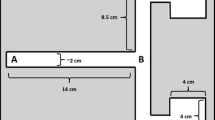Abstract
Major workers are the dominant caste in foraging parties of Macrotermes michaelseni; they also have the largest sternal gland, with the highest potential trail-laying activity. The termite utilizes pheromonal trails along open-air foraging routes, surface galleries and in the subterranean gallery network. Thus, surface galleries appear to serve primarily as protective structures to foraging traffic, while trails lead foragers to food sites. Well-established trails on paper lost activity within 2–3 hr under open-air field conditions. In a choice situation, a trail leading to food source was 30–40 times stronger than that directed to an empty food chamber, suggesting that food influences trail-laying and recruitment behaviour of the termite.
Similar content being viewed by others
References
Bruinsma O. H. (1979) Analysis of building behaviour of the termite Macrotermes subhyalinus (Rambur). Ph.D. thesis. Landbouwweternschappen, Landbouwhogeschool, Wageningen, p. 86.
Leuthold R. H. and Lüscher M. (1974) An unusual caste polymorphism of the sternal gland and its trail pheromone production in the termite Trinervitermes bettonianus. Insectes soc. 21, 335–341.
Oloo G. W. (1981a) specificity of termite trails: Analysis of natural trails of Trinervitermes, Macrotermes and Odontotermes from sympatric populations. Entomologia exp. appl. 29, 162–168.
Oloo G. W. (1981b) The sternal gland: Variation in size and activity in worker instars of Trinervitermes bettonianus (Sjost) (Termitidae). Insect Sci. Applic. 2, 145–147.
Oloo G. W. and Leuthold R. H. (1979) The influence of food on trail-laying and recruitment behaviour in Trinervitermes bettonianus (Termitidae: Nasutitermitinae). Entomologia exp. appl. 26, 267–278.
Pasteels J. M. (1965) Polyethisme chez les ouvries de Nasuti termes lujae (Termitidae, Isopteres). Biol. Gabonica 1, 191–205.
Quennedy A. and Leuthold R. H. (1978) Fine structure and pheromonal properties of the polymorphic sternal gland in Trinervitermes bettonianus (Isoptera, Termitidae). Insectes soc. 25, 153–162.
Stuart A. M. (1969) Social behaviour and communication. In Biology of Termites I (Edited by Krishna K. and Weesner F. M), pp. 193–232. Academic Press, New York.
Traniello J. F. A. (1981) Enemy deterrence in the recruitment strategy of a termite-soldier-organized foraging in Nasutitermes costalis. Proc. natn. Acad. Sci. U.S.A. 78, 1976–1979.
Author information
Authors and Affiliations
Rights and permissions
About this article
Cite this article
Oloo, G.W. Some Observations on the Trail-Laying Behaviour of Macrotermes Michaelseni (Sjöst) (Termitidae). Int J Trop Insect Sci 5, 259–262 (1984). https://doi.org/10.1017/S1742758400001533
Received:
Accepted:
Published:
Issue Date:
DOI: https://doi.org/10.1017/S1742758400001533




